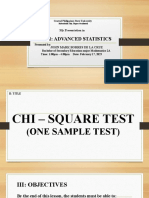Definition of Chi-Square Test
Uploaded by
Dharshu RajkumarDefinition of Chi-Square Test
Uploaded by
Dharshu RajkumarDEFINITION OF CHI-SQUARE TEST:
A chi-square test, also referred to as chi-squared test or 2 test, is any statistical hypothesis test in which the sampling distribution of the test statistic is a chi-square distribution when the null hypothesis is true, or any in which this is asymptotically true, meaning that the sampling distribution (if the null hypothesis is true) can be made to approximate a chi-square distribution as closely as desired by making the sample size large enough. PURPOSE OF CHI-SQUARE: The Chi Square (X2) test is undoubtedly the most important and most used member of the nonparametric family of statistical tests. Chi Square is employed to test the difference between an actual sample and another hypothetical or previously established distribution such as that which may be expected due to chance or probability. Chi Square can also be used to test differences between two or more actual samples. BASIC COMPUTATIONAL EQUATION:
DEGREES OF FREEDOM: 1) A value of X2 cannot be evaluated unless the number of degrees of freedom associated with it is known. The number of degrees of freedom associated with any X2 may be easily computed. 2) If there is one independent variable, df = r - 1 where r is the number of levels of the independent variable. 3) If there are two independent variables, df = (r - l) (s - l) where r and s are the number of levels of the first and second independent variables, respectively. 4) If there are three independent variables, df = (r l) (s - 1) (t - 1) where r, s, and t are the number of levels of the first, second, and third independent variables, respectively.
THE CHI - SQUARE TEST:
The chi-square test is a nominal level nonparametric test of significance that could be used to test the differences or relationship between two variables. It applies only to discrete data that are counted rather than data with measured values (Kinnear, & Gray, (1994). As a nonparametric test useful when data are in the form of frequency counts, the chi-square
occurs in two or more mutually exclusive categories and it is denoted by the following formula:
Where P2 = Chi square; O = Observed frequency; E = Expected Frequency. USES OF CHI -SQUARE:
1) The Chi-square test is useful when the data collected represent a nominal scale and categories are true categories such as male and female or artificial categories such as tall and short. 2) It compares proportions that were observed in a study with proportions expected if the groups were equal. 3) In computing chi-square, therefore, the differences between the observed frequency and expected frequency are squared and divided by the expected number on each occasion. The sum of these quotients is the Chi-square value. 4)The significance of a Chi-square value is determined by consulting a Chi-square table using the appropriate degree of freedom and level of significance (Moore, 1994). It should be
noted however, that the Chi-square value increases as the difference between observed and expected frequencies increases.
CHI-SQUARE GOODNESS OF FIT TEST:
Also known as goodness of fit, in the sense that it is a test of last result, the Chi-square statistic helps in determining whether observations differ from what is expected by chance. It is also referred to as a goodness of fit statistic because it is a statistical evaluation of the difference between sample observations and observations provided by a hypothesized model (Champion, 1970). In analyzing data with the Chi-square goodness of fit, variables could be discrete while data should be at the nominal level of measurement for an appropriate analysis.
ONE DIMENSIONAL CHI-SQUARE:
This is a type of Chi-square test presented in a 1 x 2 or 1 x 3 or more, that is, one row, two columns or one row, three columns or one row, more than three columns contingency table.
Example: The expected frequencies (E) in cell 1 = 60; Expected frequencies (E) in cell 2 = 60; Observed Frequencies (O) in cell 1 = 75; observed frequencies (O) In cell 2 = 4 (Table 1). Having determined the expected and observed values, then apply the Chi square formula.
TWO- DIMENSIONAL CHI-SQUARE:
The Chi square might also be used when frequencies are categorized along more than one dimension. This is a kind of a factorial Chi-square. Although 2 x 2 tables are common, contingency tables might be for any number of categories, such as 2 x 3, 2 x 4 or 3 x 3 tables.
Example:
To compute the expected frequencies for each cell, multiply the total of each row by the total of the corresponding column and divide by the overall total (Table 2). .For Row 1, column 1:
CHI-SQUARE TEST FOR TWO INDEPENDENT SAMPLES: The Chi-square test for independent samples is a useful statistical technique for determining whether two nominal or higher level measures are related. It is used when dealing with more than one sample. If one of the variables is an independent variable and the other is a dependent variable, the test may be used to analyze data from a simple randomized design, which may be either experimental or ex-post-facto design. There is no restriction whatsoever in respect of the categories either in the roll or column variables .After determining the expected and
observed values in the appropriate contingency tables, then apply the Chi-Square formula.
TESTING FOR SIGNIFICANT RELATIONSHIP: In order to test whether there is any relationship in the pattern of responses, the Crammers r Contingency Coefficient and Index Relationship (Cr) is determined. The Crammers(Cr) is to test how strong or loose the relationship is. The following formula is.
ASSUMPTIONS FOR CHI-SQUARE TEST:
There are some restrictions with respect to the sample size. No cell should have an expected frequency of less than 5 (Champion, 1970). If however, cell frequencies are less than 5, the resulting Chi-square value would be grossly inflated and would not reveal a true picture of the ways the
variables are distributed. However, categories might be collapsed in order to raise the expected frequencies above 5. C It is also assumed that the researcher must obtain a sample of independent observations.
ADVANTAGES FOR CHI-SQUARE TEST: 1) The Chi-square test is the most flexible statistical technique for determining whether ones observations differ from what is expected by chance. 2) Tables are usually provided which allow the researcher to determine the significance of any given Chi-square value with the appropriate number of degrees of freedom. 3) Because few assumptions exist with Chi square, it is possible to apply the Chi- square to virtually every analysis where data are in categories.
DISADVANTAGES FOR CHI-SQUARE TEST: 1) One major disadvantage for using the Chi square test is with small N. 2) When N is less than 5, the Chi- square test should not be applied.
You might also like
- Chi-Square Test: Amaresh Baranwal - 2021301073 Pratham Maner - 2021301074No ratings yetChi-Square Test: Amaresh Baranwal - 2021301073 Pratham Maner - 202130107414 pages
- Chi-Square Test: An Inferential Statistics Technique Designed To Test ForNo ratings yetChi-Square Test: An Inferential Statistics Technique Designed To Test For2 pages
- DDBA 8437: Nonparametric Statistics: The Chi-Square Test Video Podcast TranscriptNo ratings yetDDBA 8437: Nonparametric Statistics: The Chi-Square Test Video Podcast Transcript5 pages
- Module 5a Chi Square - Introduction - Goodness of Fit TestNo ratings yetModule 5a Chi Square - Introduction - Goodness of Fit Test39 pages
- Learn Statistics Fast: A Simplified Detailed Version for StudentsFrom EverandLearn Statistics Fast: A Simplified Detailed Version for StudentsNo ratings yet
- Engineering Applications of Artificial Intelligence: Bipul Luitel, Ganesh K. VenayagamoorthyNo ratings yetEngineering Applications of Artificial Intelligence: Bipul Luitel, Ganesh K. Venayagamoorthy15 pages
- Hyper-V Generation 2 Virtual Machines - Part 4No ratings yetHyper-V Generation 2 Virtual Machines - Part 45 pages
- Department of Education: Republic of The PhilippinesNo ratings yetDepartment of Education: Republic of The Philippines3 pages
- CAT 2012 Quantitative Aptitude - The Cyclicity of Remainders - PaGaLGuY News & ChannelsNo ratings yetCAT 2012 Quantitative Aptitude - The Cyclicity of Remainders - PaGaLGuY News & Channels9 pages
- Chapter 14 Association Rules Collaborative FilteringNo ratings yetChapter 14 Association Rules Collaborative Filtering34 pages
- BlueRoom - Onboarding - PractitionerV1.6No ratings yetBlueRoom - Onboarding - PractitionerV1.631 pages
- Spoto Ccie Lab Rs v5.0 Ts2 Bt1 Qbook v1.0No ratings yetSpoto Ccie Lab Rs v5.0 Ts2 Bt1 Qbook v1.08 pages
- Atlys ™ FPGA Board Reference Manual: Spartan-6No ratings yetAtlys ™ FPGA Board Reference Manual: Spartan-619 pages
- Unit 4 - RM - Computer and Its Role in ResearchNo ratings yetUnit 4 - RM - Computer and Its Role in Research2 pages
- CRUD Operation On Google Spreadsheet Using NodeJS - Agira Technologies - MediumNo ratings yetCRUD Operation On Google Spreadsheet Using NodeJS - Agira Technologies - Medium22 pages
- Chi-Square Test: Amaresh Baranwal - 2021301073 Pratham Maner - 2021301074Chi-Square Test: Amaresh Baranwal - 2021301073 Pratham Maner - 2021301074
- Chi-Square Test: An Inferential Statistics Technique Designed To Test ForChi-Square Test: An Inferential Statistics Technique Designed To Test For
- DDBA 8437: Nonparametric Statistics: The Chi-Square Test Video Podcast TranscriptDDBA 8437: Nonparametric Statistics: The Chi-Square Test Video Podcast Transcript
- Module 5a Chi Square - Introduction - Goodness of Fit TestModule 5a Chi Square - Introduction - Goodness of Fit Test
- Learn Statistics Fast: A Simplified Detailed Version for StudentsFrom EverandLearn Statistics Fast: A Simplified Detailed Version for Students
- Chi-squared Goodness-of-fit Tests for Censored DataFrom EverandChi-squared Goodness-of-fit Tests for Censored Data
- Engineering Applications of Artificial Intelligence: Bipul Luitel, Ganesh K. VenayagamoorthyEngineering Applications of Artificial Intelligence: Bipul Luitel, Ganesh K. Venayagamoorthy
- Department of Education: Republic of The PhilippinesDepartment of Education: Republic of The Philippines
- CAT 2012 Quantitative Aptitude - The Cyclicity of Remainders - PaGaLGuY News & ChannelsCAT 2012 Quantitative Aptitude - The Cyclicity of Remainders - PaGaLGuY News & Channels
- Chapter 14 Association Rules Collaborative FilteringChapter 14 Association Rules Collaborative Filtering
- CRUD Operation On Google Spreadsheet Using NodeJS - Agira Technologies - MediumCRUD Operation On Google Spreadsheet Using NodeJS - Agira Technologies - Medium
























































































